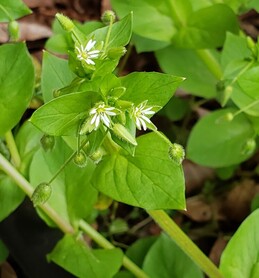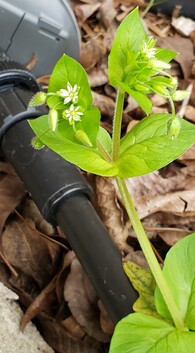|
The photos above are Chickweed I found in my garden. I'm all excited because there's a bunch of it growing in my yard right now. While DH is not happy about the abundance of "weeds" that have taken over our yard, I'm thrilled that I can begin foraging (instead of buying all my herbs), and Chickweed will be the first plant I gather this year. (Thanks to Rosalee de la Foret's FB page that goes with her soon-to-be-published book Wild Remedies, I'm now learning how to identify the specific plants in my own front yard!)
This beautiful plant makes its appearance at the start of Spring. Along with dandelions, it provides early food for bees and humans. If your yard hasn't been treated with harsh chemicals, you can harvest the stems, leaves, and flowers of Chickweed for multiple uses. As a food, Chickweed can be used in salads, cooked in foods (like other herbs), made into a pesto or juice, infused into vinegar, oil, and honey, taken as tea, and taken as tincture. Topically, it can be used as a poultice, and eye rinse, a salve, or infused in a bath. Energetically, Chickweed is cooling and moistening and best for those who have a hot, dry constitution. Therapeutically, this "weed" offers significant nutrition, including anthraquinones, calcium, coumarins, flavonoids, magnesium, phosphorous, phytosterols, potassium, saponins, and Vitamin C - talk about your healthy salad! Not only does it provide nutrition, it also helps your body absorb nutrients from other foods you eat. It's the perfect ingredient in dishes for those with anemia, or those who are recovering from surgery or illness. During times of high stress, it can help cool the heat and balance the body while encouraging detoxification by getting sluggish lymph fluid to move thereby reducing excess water and fat in the body. (Yes, it can be part of a healthy weight-loss diet.) Topically, Chickweed relieves bites, stings, and itchy skin much like Plantain does. Infuse it into oil to add to a salve or lotion, then apply to the irritated skin. If you're outside and need immediate relief, crush the leaves and apply them to the abraded area. Chickweed can be infused in water, then cooled to use as an eyewash to relieve red, itchy, irritated, dry eyes or to help with conjunctivitis and sties as it has antiviral properties. This hardy little weed has huge potential in your home apothecary and in your diet. It likes the cooler weather in spring and fall -- you can usually harvest it in those seasons before the flowers bloom or while they are blooming. Once they have gone to seed, the plant will be too tough for food. If you are new to harvesting your own herbs from your own yard, make sure the plants you acquire are the ones you want to use. Chickweed is a very safe herb, but there are a couple of poisonous plants (Spurge and Scarlet Pimpernel) that could easily be mistaken for Chickweed by the novice. To learn more about Chickweed, become a member and read about all its benefits on the Datasheet on this website. Resources: 1. Bruton-Seal, Julie, Seal, Matthew, Backyard Medicine: Harvest and Make Your Own Herbal Remedies, 2nd Edition, Skyhorse Publishing New York, NY, (c) 2009, 2019, pages 42 - 45 2. Easley, Thomas, Horne, Steven, The Modern Herbal Dispensatory: A Medicine-Making Guide, North Atlantic Books, Berkeley, California, (c) 2016, pages 210 - 211 3. Hutchens, Alma R., Indian Herbalogy of North America: The Definitive Guide to Native Medicinal Plants and Their Uses, Shambhala Publications, Boulder, Colorado, (c) 1973, pages 87 - 88 4. Moerman, Daniel E, Native American Medicinal Plants: An Ethnobotanical Dictionary, Timber Press, Portland, Oregon, (c) 2009, page 468 5. Pursell, JJ, The Herbal Apothecary: 100 Medicinal Herbs and How to Use Them, Timber Press, Portland, Oregon, (c) 2016, pages 88 - 89 6. Upton, Roy et. al., Botanical Safety Handbook, Second Edition, CRC Press, (c) 2013, pages 818 - 819 7. Physician's Desk Reference, PDR for Herbal Medicines: Third Edition, Thomson, (c) 2004, page 191 8. de la Forêt, Rosalee, Chickweed Monograph, Herbmentor, (c) 2020, https://herbmentor.learningherbs.com/herb/chickweed/, Accessed March 10, 2020
0 Comments
Leave a Reply. |
DisclaimerThe information contained in this blog is for educational purposes only and has not been evaluated by the Food and Drug Administration. Archives
March 2021
Categories |


 RSS Feed
RSS Feed